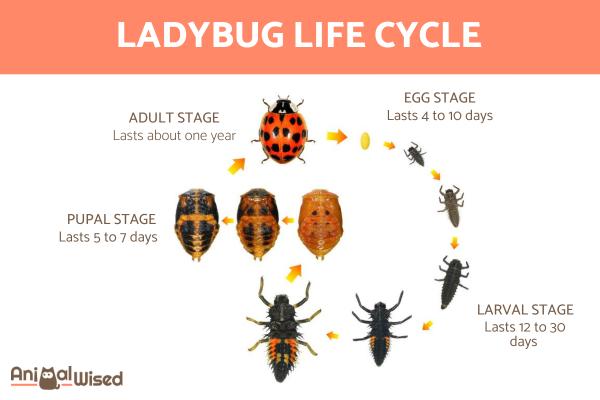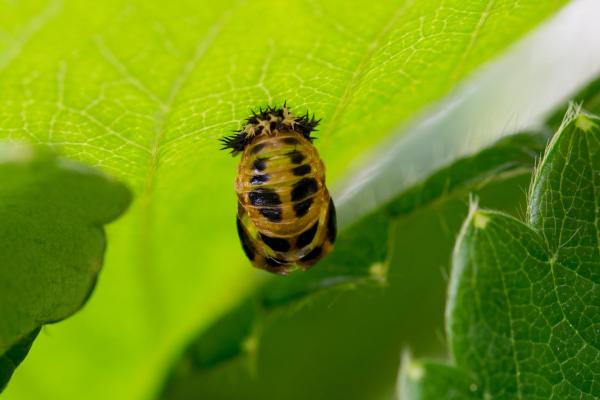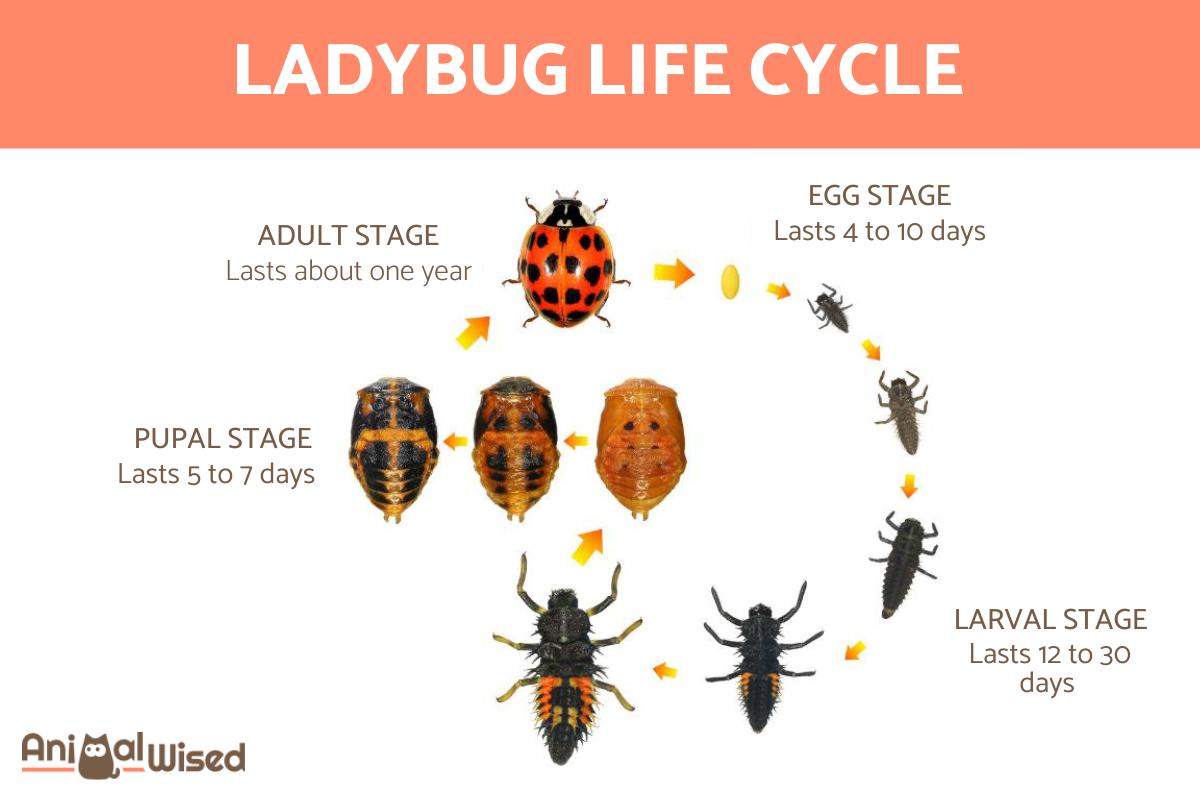How Long Do Lady Bugs Live?


Ladybugs, also known as ladybugs or lady beetles, are a type of beetle belonging to the Coccinellidae family. They are widely known for their small, round, brightly colored bodies and the black spots on their backs. They have a relatively short lifespan compared to other insects, but this can vary depending on the species and the environmental conditions in which they live.
The following AnimalWised article explains how long ladybugs live, as well as some other important information about their life cycle.
Life cycle of the ladybug
The life cycle of ladybugs is influenced by the environmental conditions in their habitat. In extreme temperatures, whether cold, hot or dry, ladybugs do not reproduce and enter a state of inactivity called diapause.
Ladybugs can have a reproductive cycle that occurs either once a year, which is called univoltine, or at least twice a year, which is called bivoltine. The reproductive process is sexual and involves internal fertilization. Adult ladybugs mate and lay eggs on the underside of leaves, often near colonies of aphids, which will serve as a food source for their offspring.
Ladybugs are holometabolous animals, which means that they undergo a complete metamorphosis consisting of different stages of their life cycle.
The life cycle of the ladybug consists of four stages: egg, larva, pupa, and adult. Each of these stages is characterized by different physical features and behaviors, and understanding these stages can help us better understand the life span of ladybugs.
If you want to know more about ladybugs, do not miss this other article where we talk about what ladybugs eat.
Egg stage
The appearance of ladybug eggs can vary by species, as not all eggs follow the same pattern. Some ladybug eggs are more oval, while others are almost spherical. The average size of ladybug eggs is about 1 mm, but can range from 0.25 to 2.5 mm. For example, the genus Stethorus typically has very small eggs, while the genus Neda produces larger eggs.
Ladybug eggs typically have a smooth and shiny exterior, with no edges or protrusions, unlike other insect species. The color of the eggs is usually yellow, cream, or orange, but they can also be green or grayish. As the embryo develops, the eggs turn darker, and when they hatch, the larvae are white.
How many eggs does a ladybug lay?
A female ladybug typically lays about 50 eggs per season, producing a total of between 300 and 500 eggs during her lifetime. However, in certain bivoltine species, they may lay up to a thousand eggs during their lifetime.
Ladybug eggs are usually laid on plants, and some females lay their eggs on multiple plants to ensure dispersal of their offspring. Interestingly, two ladybugs do not often lay their eggs on the same plant.
One notable aspect of ladybug eggs is that they are nutritious, as they are often the first meal for the larvae when they hatch. In cases where little food is available, females may produce unfertilized eggs that provide food for the larvae when they hatch.
Once the female lays the eggs, it takes about 4–10 hours for them to hatch. This means that the embryo develops quickly before moving on to the next stage of the ladybug's life cycle, the larva.
You may be interested in this other article, where we talk about how long the life cycle of a butterfly is.

Larval stage
Ladybug larvae are usually active and feeding. Once hatched, they begin to eat the egg from which they hatched and any unfertilized eggs in the environment.
In some cases, ladybug larvae can grow larger than adult beetles. They have a chitinous structure covering their bodies, often with serous or furry appendages, and can have different shapes and sizes depending on the species. Some even have limbs for locomotion, while others resemble tiny worms.
Ladybug larvae have voracious appetites and feed on a wide variety of insects, including aphids, mites, and other small arthropods. They have strong jaws and can consume numerous prey relative to their body size. Some species of ladybugs can also feed on plant material during their larval stage.
Ladybug larvae molt several times during their growth, shedding their outer skin to reveal a larger skin underneath. The number of molts varies by species, but most ladybug larvae go through three to five stages before pupating.
Initially, they are typically light or grayish, but may change to other colors, such as yellow or orange, as they progress through the various stages.
The larval stage typically lasts between 12 and 20 days, but the duration can vary depending on the species. In some species, it can take a month or even longer to complete this stage.

Pupal stage
As with many other insects, ladybugs are less active during the pupal stage. The pupal stage of ladybugs is a period of dormancy and metamorphosis, during which the larva transforms into an adult beetle. The pupa does not consume food and its main function is metamorphosis.
Instead of being enclosed in a cocoon, pupae are covered and protected by a tissue that may have small visible hairs in some species. This protective tissue is called puparium and is formed by the hardening of the larval skin. The puparium is usually yellow, orange, or brown and its size and shape varies among species.
Ladybug pupae attach the base of their body to some part of a plant or surface. The pupa is normally immobile, but can move when disturbed.
Inside the puparium, the larva undergoes a process of complete transformation in which it reshapes its body structure and develops wings, legs, and other adult features. This process usually takes 5-7 days, but in some species it can take up to 2 weeks.
Once metamorphosis is complete, the adult ladybug hatches from the puparium, leaving behind the empty pupal case. The exoskeleton of the adult beetle is soft at first, and it takes a few hours for it to harden and darken. The adult ladybug is fully mature and ready to mate and reproduce.

Adult stage
The adult stage of a ladybug is the last stage of its life cycle. The newly hatched adults are usually brightly colored and have soft bodies, but they quickly become harder and darker over the next few hours. The most common species of ladybugs are often brightly colored, with red or orange wing covers (the hardened forewings), black spots, and a black head. However, there are many species with a wide range of colors and patterns.
Unlike some other insects that remain in their adult stage for only a short time, ladybugs have a longer adult stage, with univoltine species living for at least a year and bivoltine species having an even longer lifespan.
These insects can be found throughout the year as long as environmental conditions are favorable. During periods of unfavorable conditions, they go into diapause.
Ladybugs can mate before entering diapause. Females store sperm and fertilization occurs after they leave diapause.
Adult ladybugs are active insects that feed on a variety of small insects such as aphids, mites, and scale insects. In many parts of the world, they are considered beneficial insects because they help control pest populations in gardens and farms.

How long does a ladybug live in total?
In summary, the life cycle of ladybugs varies by species, but on average it takes about a month from egg laying to emergence as an adult. Ladybugs generally live about a year from birth to death, but in bivoltine species or during diapause, this period may be longer.
If you want to read similar articles to How Long Do Lady Bugs Live?, we recommend you visit our Facts about the animal kingdom category.
- Animal Diversity Web (2020). Available at: https://animaldiversity.org/
- Britannica (2020). ladybug . Britannica Encyclopedia. Available at: https://www.britannica.com/animal/ladybug
- González, G. (2006). Coccinellidae in Chile. Development from egg to adult . Available at https://www.coccinellidae.cl/paginasWebChile/PaginasOriginal/desarrollo.php#:~:text=Los%20Coccinellidae%20son%20especies%20muy,ponendo%20huevos%20por%20varios%20meses









